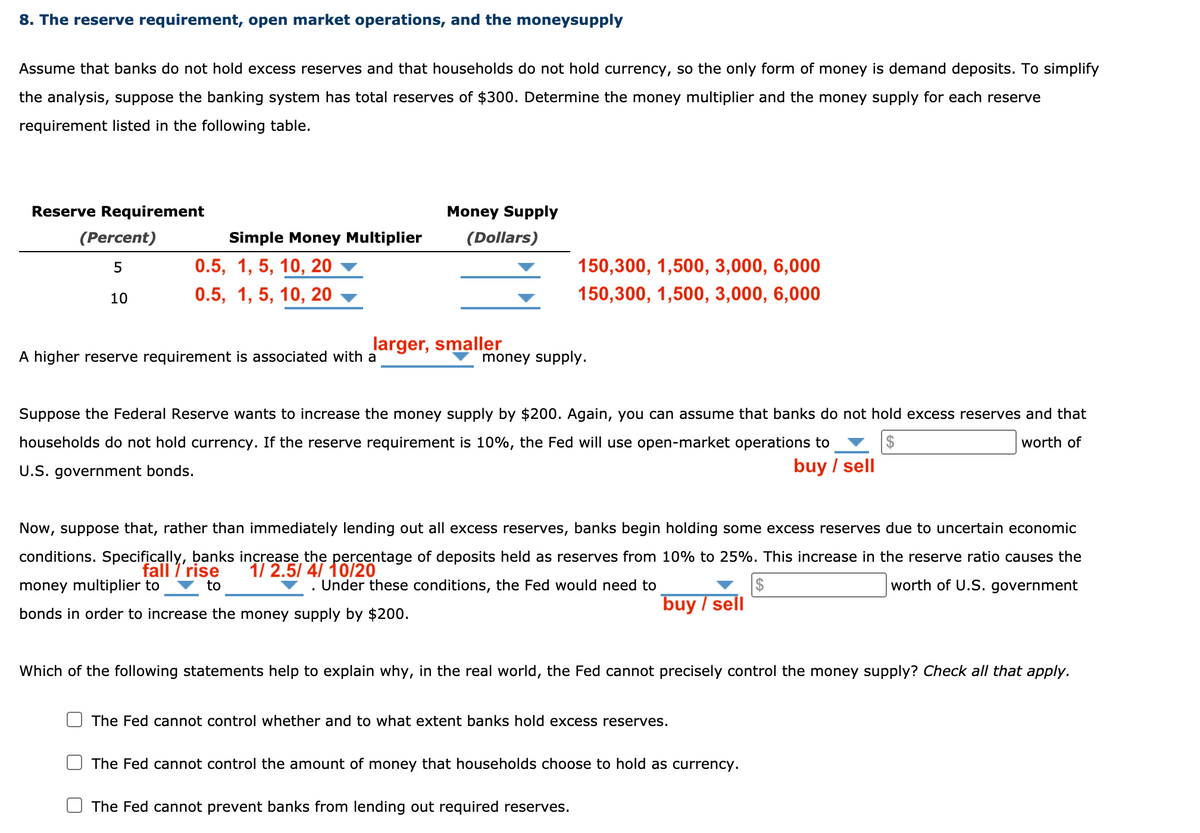8. The reserve requirement, open market operations, and the moneysupply Assume that banks do not hold excess reserves and that households do not hold currency, so the only form of money is demand deposits. To simplify the analysis, suppose the banking system has total reserves of $300. Determine the money multiplier and the money supply for each reserve requirement listed in the following table. Reserve Requirement Money Supply (Percent) Simple Money Multiplier (Dollars) 0.5, 1, 5, 10, 20 150,300, 1,500, 3,000, 6,000 5 10 0.5, 1, 5, 10, 20 150,300, 1,500, 3,000, 6,000 larger, smaller A higher reserve requirement is associated with a money supply. Suppose the Federal Reserve wants to increase the money supply by $200. Again, you can assume that banks do not hold excess reserves and that households do not hold currency. If the reserve requirement is 10%, the Fed will use open-market operations to worth of U.S. government bonds. buy / sell Now, suppose that, rather than immediately lending out all excess reserves, banks begin holding some excess reserves due to uncertain economic conditions. Specifically, banks increase the percentage of deposits held as reserves from 10% to 25%. This increase in the reserve ratio causes the fall 'rise 1/ 2.5/ 41 10/20 v to money multiplier to Under these conditions, the Fed would need to worth of U.S. government buy / sell bonds in order to increase the money supply by $200. Which of the following statements help to explain why, in the real world, the Fed cannot precisely control the money supply? Check all that apply. The Fed cannot control whether and to what extent banks hold excess reserves. O The Fed cannot control the amount of money that households choose to hold as currency. O The Fed cannot prevent banks from lending out required reserves.
IS-LM-PC Analysis
The IS (Investment Saving), LM (Liquidity Preference- Money Supply), and PC (Philips Curve) is the model that looks at the dynamics of output and inflation. It takes into account the central bank policy decision to adjust the inflation and real interest rate in the economy. It enables the economist to weather to priorities between employment and inflation rate analyzing the model. It is a practice-driven approach adopted by economists worldwide.
IS-LM Analysis
The term IS stands for Investment, Savings, and LM stands for Liquidity Preference, Money Supply. Therefore, the term IS-LM model is known as Investment Savings – Liquidity preference money Supply. This model was introduced by a Keynesian macroeconomic theory which shows the relationship between the economic goods market and loanable funds market or money market. In other words, it shows how the market for real goods interacts with the financial markets to strike a balance between the interest rate and total output in the macroeconomy. This particular model is designed in the form of a graphical representation of the Keynesian economic theory principle. The output and money are the two important factors in an economy.
Assume that banks do not hold
- A higher reserve requirement is associated with a __larger, smaller__money supply.Suppose the Federal Reserve wants to increase the money supply by $200. Again, you can assume that banks do not hold excess reserves and that households do not hold currency. If the reserve requirement is 10%, the Fed will use open-market operations to ____buy / sell_$___________worth of U.S. government bonds.
- Now, suppose that, rather than immediately lending out all excess reserves, banks begin holding some excess reserves due to uncertain economic conditions. Specifically, banks increase the percentage of deposits held as reserves from 10% to 25%. This increase in the reserve ratio causes the money multiplier to __fall / rise__to __1/ 2.5/ 4/ 10/20__. Under these conditions, the Fed would need to ___buy / sell $_____worth of U.S. government bonds in order to increase the money supply by $200.
Which of the following statements help to explain why, in the real world, the Fed cannot precisely control the money supply? Check all that apply.
- The Fed cannot control whether and to what extent banks hold excess reserves.
- The Fed cannot control the amount of money that households choose to hold as currency.
- The Fed cannot prevent banks from lending out
required reserves.

Trending now
This is a popular solution!
Step by step
Solved in 2 steps with 2 images









